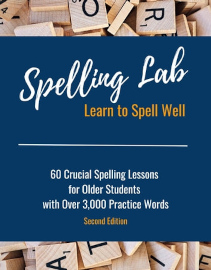Spelling Lab: Learn to Spell Well is a 157-page book designed to help students in third grade and above who struggle with spelling. It uses Orton-Gillingham methodology to present a highly structured, phonetically based method of figuring out how words are spelled, the same method used by many dyslexia therapists. While it should be particularly useful for students with dyslexia, it should work as well for most students who struggle with spelling.
Lessons are taught with continual interaction between teacher and student(s). Students learn to predict the likely spelling of a word based on predictable spelling patterns and learn to identify syllable breaks and accented syllables. Charts are used throughout the book to present the patterns and rules. (The charts are also provided in a consolidated form in an appendix at the back of the book—four charts that are introduced before the first, sixteenth, thirty-first, and forty-sixth lessons.)
The process is fairly simple in the beginning but becomes more complex in later lessons. For instance, Lesson 42 (out of 60 lessons) teaches advanced skills for the spelling of a final /s/ sound in words by presenting four patterns:
In the final position, the sound (s) is spelled ss after a short vowel in an accented syllable (FLOSS rule).
In the final position, the sound (s) is spelled s after a short vowel in an unaccented syllable.
In the final position, the sound (s) is spelled se after two vowels or a consonant.
In the final position, the sound (s) is spelled ce after a long vowel.
As in all lessons, the teacher uses the provided practice words for students to work through each word systematically. Students isolate the sounds, determine their positions in the word (initial, medial, or final), consider spelling possibilities based on information in the chart, consider the influence of syllable breaks, consider whether an accented syllable affects the spelling, and look for open or closed syllables to help determine whether vowel sounds are long or short. The process grows in complexity from mono- to multisyllabic words.
Applying this process to the word loose works like this. The word can be broken down (or unblended) into the sounds (l) (oo) (s). Students tap, write dots or lines, or move objects as they identify each sound. The initial (l) sound is easy—it was reviewed in the fifth lesson. At this point, students have also learned to spell the (oo) sound in Lesson 14. To determine the spelling of the (s) sound they look at the chart and see that the third rule I listed above applies in this case, so the word ends with the spelling se.
Students should be given copies of the charts for reference. The teacher uses the book, and students do their writing in a notebook or elsewhere.
The lessons build sequentially. However, an older student might already be familiar with some spelling patterns, so a pre-assessment is included. If students can correctly spell at least 20 of the 25 words, then you might have them begin with Lesson 31. Otherwise, you should use all lessons in order. Plenty of practice and review is built into the lessons.
Two Post Assessments are included in the middle and end of the course. Two Review Maps help parents identify the lessons covering elements of words that children misspelled on the assessments or in another context. Parents can revisit the pertinent lessons as needed.
The course does not teach vocabulary, but I wouldn’t be surprised if homeschoolers took time to discuss the meanings of unfamiliar words, especially some of the practice words introduced toward the end of the course, such as febrile, recumbent, and misconstrue. Students do not need to know the meaning of the words to be able to spell them, but discussing their meanings might help students remember them.
The amount of time the course will take to complete varies from student to student. If lessons are taught every day, a student might finish in about three months, but six months or longer is more typical.
Summary
Spelling Lab: Learn to Spell Well requires time and effort from both parents and students, but students become familiar with patterns and rules that take most of the guesswork out of spelling. Parents who despair of their children ever becoming proficient spellers really should try this.








